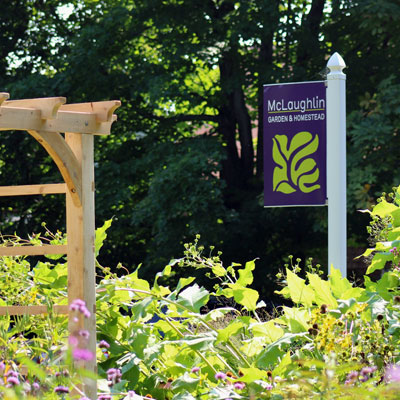
The Garden
When the property was planted in 1936, the land had little more to offer than fallow fields and sandy soil. Almost a century later, the over two acres of perennial plantings at McLaughlin Garden encompass a unique blend of different garden types— from shady woodlands bursting with spring color to swaying wildflower meadows.
Planted with multiple seasons of interest in mind, the gardens will always have something to offer, no matter which time of year you choose to visit.

The Collections
Bernard McLaughlin’s Historic Lilacs
For almost a century now, thousands have flocked to the garden each May to witness the blooming lilac collection’s intoxicating aroma and dazzling shades of purple. Bernard McLaughlin experimented with various gardening styles and plant species, but he clearly had an affinity for lilacs, having planted over 125 cultivars and 200 individual bushes over his lifetime. These historic lilacs are still thriving today under the care of McLaughlin Garden’s horticultural staff.
Pond Garden and Rock Garden
Complete with vibrant water lilies and friendly amphibians, the running water of this garden is a refreshing sight in the summer heat, as is the deep shade provided by a pink-leaved Tricolor Beech that hangs over the water.
Surrounding the pond are outcroppings of rock covered in hens and chicks (Sempervivum spp.), with a sea of barrenwort (Epimedium spp.) flowing overhead.
Adjacent to the Pond Garden is the Rock Garden, the newest addition to McLaughlin’s collection of gardens. Despite its diminutive size, this garden boasts a variety of alpine species and ledge-loving succulents.
Pollinator Garden
Pollinators are the foundation of any garden- and ecosystem, for that matter- and are critical if we hope to mitigate the effects of climate change.
Our University of Maine Cooperative Extension certified “Pollinator Friendly” garden exists to inspire our visitors to make their home gardens more palatable for bees, butterflies and other pollinators. Our pollinator garden consists of eco-region native, minimally cultivated species that provide pollinators and wildlife with food year-round.
Primrose Bed
Bordering the northern edge of the historic barn, the Primrose Bed is best known for a bounty of vibrantly blooming Primula every spring. From cowslips to Japanese primrose, and in every color imaginable, the Primrose Bed is a small garden that packs a colorful punch.
In addition to primrose, this bed also hosts an assortment of woodland species such as lungwort, trout lily, Jack-in-the-pulpit, and the ever-tall, ever-majestic Canada lily.
McEwen Siberian Iris Collection
This Siberian Iris collection is the nearly-40-year legacy of esteemed hybridizer and friend to Bernard McLaughlin, Dr. Currier McEwen.
Known throughout the horticultural community for his contributions to the development of new iris cultivars, Dr. McEwen’s irises are now staples of the horticultural trade, found in gardens and nurseries around the world.
Originally divided from McEwen’s home garden in Harpswell, Maine, the historic Iris Collection now has a home at McLaughlin Garden.
Wildflower Lane
Although you may think you’ve been transported to a remote wildflower-laden forest trail, Wildflower Lane is a colorful part of McLaughlin Garden. The mixed deciduous/coniferous canopy and rich forest soil make this garden the perfect environment for an array of rare and wonderous spring ephemeral wildflowers. A bounty of wakerobins, windflowers, and trout lilies call this garden home, along with more ferns than you can shake a frond at.
Gathering Lawn and Shade Garden
Upon exiting the barn, the Gathering Lawn and Shade Garden immediately come into focus. As its name suggests, the Gathering Lawn is the perfect spot to mingle with other garden-loving guests while taking in the lush scenery.
The Shade Garden serves as the backdrop to the scene- saturated in a range of green hues from under story to canopy. The collaborative atmosphere these two gardens create is pure tranquility.
Core Garden
Encompassing a substantial portion of the property’s acreage and centrally located, the Core Garden is truly the “heart” of our gardens.
The Core Garden is home to many of the Lilac varieties on the property, but swaths of Astilbe, Phlox, Lobelia, and Paeonia are also found here. Diverse in plant species, the garden varies considerably from one spot to the next due to different overstory, canopy, and soil compositions.


